The Wizard Of Oz
 From Conservapedia
From Conservapedia 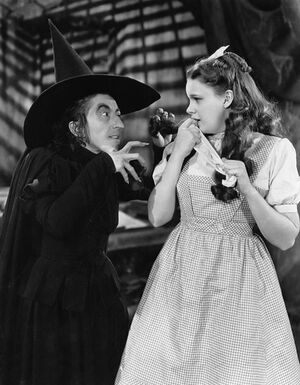
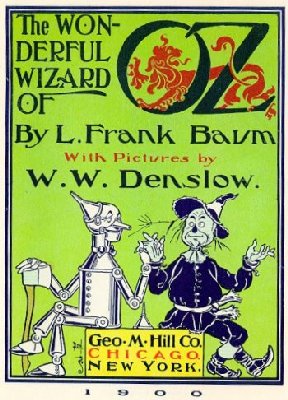
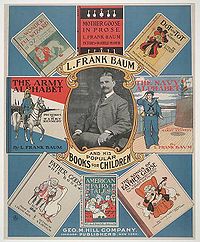
The Wizard of Oz was a promotion of populism as a successful book (1900), Broadway musical (1902), and movie (1939).[1] The politically incorrect Wicked Witch of the West was so terrifying that she caused widespread nightmares, and the actress's reenactment nearly 40 later on Sesame Street sparked so many complaints that the episode was banned.[2] Pink Floyd denies comparisons between its bestsellingThe Dark Side of the Moon album and the movie, which is considered by many to be the most popular movie ever.[3]
Dorothy, the Wizard, the Scarecrow, Tin Woodman, Cowardly Lion, flying monkeys, Munchkins, the yellow brick road, the dream city of Oz, Toto—and especially the Wicked Witch—have become icons of American popular culture. They appear regularly in editorial cartoons and the funny papers, and even in everyday conversation. Political cartoonists used the Wizard image as early as 1906; in recent years Wizard themes appear in editorial cartoons on a weekly basis in the U.S. TIME magazine wrote in 1967 that this movie had become “the most popular single film property in the history of U.S. television.”[4]
Academics, especially economists and historians, use the story to study the images of politics and economics in the U.S. in the 1890s. Several hundred college level economics courses feature a unit on the Wizard of Oz to analyze money policy. "Emerald City," the mythical capital of the Land of Oz, is a term often used today to mean Washington, D.C. or other self-deluded, illogical centers of power.
The author was L. Frank Baum (1856-1919); the illustrator of the 1900 book and 1902 play was editorial W. W. Denslow (1856-1915).[5] The book was a runaway best seller, though the two coauthors became alienated, and both went bankrupt. Baum recouped by moving to Hollywood and writing a new series of Oz books; the series was continued after his death in 1919, with 40 Oz books in all. The first book became a smash Chicago hit musical in 1902 and moved to Broadway in 1903. Best known is the spectacularly successful Hollywood movie adaptation of 1939, starring Frank Morgan as the Wizard, Judy Garland as Dorothy, and Margaret Hamilton as the Wicked Witch of the West, this movie (along with Gone with the Wind) was one of the first widely popular successes of Technicolor filmography.[6]
Contents
- 1 The books
- 2 Plot line
- 3 Sources
- 4 Impact on readers
- 5 Allegorical devices
- 6 Political interpretations
- 7 Metaphors
- 8 Adaptations
- 8.1 The Wizard of Oz (1939)
- 8.2 The Wiz (1978)
- 9 See also
- 10 Bibliography
- 11 External links
- 12 Trivia
- 13 Notes and references
- 14 External links
The books[edit]
The Wonderful Wizard of Oz appeared in 1900 as a children's book written by L. Frank Baum (1856-1919) and illustrated by W. W. Denslow (1856-1915). This was part of their effort to create a body of American literature in the fairy tale genre; they had already collaborated on Father Goose books. The Wizard was a great success, and Baum followed it with thirteen more books set in the land of Oz. He lost Denslow as an illustrator and was never able to recapture the success of his original work. After Baum died, Ruth Plumly Thompson continued the series with nineteen more stories, and other authors wrote additional books. The Land of Oz was one of the earliest of what fantasy fans now call "fictional universes." Like the Sherlock Holmes stories, it has attracted a large number of devoted fans, who like to discuss and write about the land of Oz as if it actually exists.
The classic 17th century Christian allegory Pilgrim's Progress inspired some of the characters and dangers described in the Wizard of Oz.[7]
Plot line[edit]
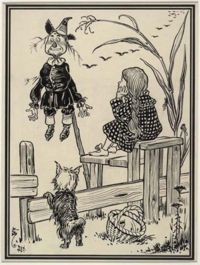
The book opens not in an imaginary far-off place, but in real life Kansas, which in the 1890s was well known for the hardships of rural life and for destructive tornadoes (also called cyclones). The Panic of 1893 caused widespread distress in rural America. In 1896, and again in 1900, the agrarian wing of the Democratic Party had seized control and nominated the firebrand orator William Jennings Bryan, from Omaha, who crusaded across the land promising his panacea of "free silver" (whereby the government would turn cheap silver into real dollars farmers could use to pay their debts). His supporters truly believed it would transform America in a veritable utopia. Baum and Denslow, Republicans, rejected this notion and use the book to poke fun at Bryan (who is depicted as the Cowardly Lion).
The silverite revolution—a cyclone—sweeps away Dorothy and Toto to a colorful land of unlimited resources that nevertheless has serious political problems. This utopia is ruled in part by wicked witches. Dorothy's cyclone/revolution destroys the Wicked Witch of the East, slave-driver over the little people (Munchkins), who now celebrate their liberation. The Witch had controlled the powerful silver slippers (which were changed to ruby in the 1939 film).
The Good Witch of the North (the northern electorate) tries to help Dorothy, but she is not very smart, does not realize the power of the slippers, and sends Dorothy down the very dangerous gold road to the Wizard, who she mistakenly believes is so powerful that he can grant her wishes. (The northern vote elected McKinley in 1896 and he passed the gold standard into law.)
Along the Yellow Brick Road, Dorothy picks up her coalition, the Scarecrow, Tin Woodman, and Cowardly Lion, who all want the Wizard to grant their urgent wishes.
The national capital, the Emerald City, is a dream-like place based on the "White City," the common name for the Chicago World's fair of 1893, which Baum and Denslow attended often. The emerald green is an illusion (everyone must wear green glasses), symbolizing the fraudulent world of greenback paper money that only pretends to have value. The Wizard/president is annoyed by his guests—by the demands of the people. He is a corrupt politician, a shrewd manipulator who seeks power for himself, ignores the needs of the people, and rules by fooling with people's minds. He selfishly sends them to destroy his enemy, the Wicked Witch of the West. If she gets them, he is rid of a nuisance. If they kill her, he will be pleased and then worry what to do next.
The Wicked Witch of the West represents the trusts, who took control of small businessmen and made them cogs in their empire, just as the Witch does with the heroes, using the Flying Monkeys as her tools. The trust issue was in the headlines, with a popular solution—one actually used in 1911 against Standard Oil to dissolve them. Dorothy heaves a bucket of water and dissolves the Wicked Witch.
The heroes return to Oz to claim their reward and expose the Wizard for a media-manipulating fraud. He has no real power and must leave Oz the way he came - on a hot air balloon. (Politicians were synonymous with metaphors like "hot air" and "full of gas.") But he is a shrewd psychologist and realizes the heroes already possess what they think they lack; they just lack self-confidence. He fills the Scarecrow's head with bran for a brain, implants a heart-shaped silk cushion inside the Tin Woodman (who now realizes his compassionate nature), makes the Lion drink a dish of "courage" and becomes king of the beasts again. He promises to take Dorothy back to Omaha, his hometown, but that plan misfires. The Good Witch of the South (the southern) vote appears. (In 1896 the South voted solidly for Bryan and free silver.) She is smarter than her sister the Good Witch of the North, and tells Dorothy to click her silver slippers three times—that believing will make it come true, and Dorothy arrives home again. It is a classic adventure story of travel to distant lands, and a story of running away from home and returning, a favorite theme for children.
Sources[edit]
Baum and Denslow did not simply invent the Cowardly Lion, Tin Woodman, Scarecrow, gold-colored Yellow Brick Road, Silver Slippers, cyclone, flying monkeys, Emerald City, little people, Uncle Henry, witches and the wizard. The images and characters used by Baum and Denslow were based on the political images that were well known in the editorial cartoons of the 1890s. Baum and Denslow built a story around them, added Dorothy whose innocence and purity are more effective than the witches' magic. They added a series of lessons to the effect that everyone possesses the resources they need if only they had self-confidence. Positive thinking was a prevalent trend in this period, and Baum was involved with the Theosophy Movement that emphasized the power of pure thoughts over material evils. Baum's point is that evil is in the mind, and it takes positive thinking, not a political revolution, to destroy it.
Baum in the 1890s edited the major national magazine for advertising in store windows, and was familiar with the elaborate mechanical displays of the Christmas story that attracted tens of thousands of spectators to the display windows of Marshall Field's, Carson Pirie Scott, and other Chicago department stores.[8] The spellbinding mechanical ingenuity (based on intricate clockwork) led many viewers to believe there must be a man behind the screen who worked all the levers.
Many of the events and characters of the book resemble the actual political personalities, events and ideas of the 1890s. The 1902 stage adaptation mentioned, by name, President Theodore Roosevelt, oil magnate John D. Rockefeller, Senator Mark Hanna and other political celebrities. (No real people are mentioned by name in the 1900 book.) Even the title has been interpreted as alluding to a political reality: oz. is an abbreviation for ounce, a unit familiar to those who fought for a 16 to 1 ounce ratio of silver to gold in the name of Bimetallism[9]
Impact on readers[edit]
The 40 Oz books had a significant impact on their young middle class readers who read them in English, Spanish, Russian, French, German, Romanian, Latin, Hebrew, or Arabic editions. Novelist Gore Vidal recalls:
Like most Americans my age (with access to books) I spent a good deal of my youth in Baum's Land of Oz. I have a precise, tactile memory of the first Oz book that came into my hands. It was the original 1910 edition of The Emerald City of Oz. I still remember the look and the feel of those dark blue covers, the evocative smell of dust and old ink. I also remember that I could not stop reading and rereading the book. But 'reading' is not the right word. In some mysterious way, I was translating myself to Oz, a place which I was to inhabit for many years .... With The Emerald City, I became addicted to reading."[10]
Allegorical devices[edit]
| Intellect | Emotion | Will |
| Hunk | Hickory | Zeke |
| Scarecrow | Tin Man | Lion |
- Dorothy represents a complete person or the human mind as a whole, while her three companions represent intellect, emotion and will.
- Dorothy, naive, young and simple, represents the American people. She is Everyman, lost in a crazy utopia who wants to get back to normalcy and the love of her family. She resembles the young hero of Coin's financial school, a very popular silverite pamphlet of 1893. In her innocence and purity she is all powerful and personally kills two witches—she is Columbia, the symbol of the nation's conscience. Columbia was the usual representation of democracy in editorial cartoons (since replaced by the Statue of Liberty.)
- The cyclone was used in the 1890s as a metaphor for a political revolution that would transform the drab country into a land of color and unlimited prosperity. The cyclone was used by editorial cartoonists of the 1890s to represent political upheaval.
- The Tin Woodman was a stock symbol in cartoons and advertising. He was originally a human but was cursed by the Wicked Witch of the East so that every time he swung his axe he sliced off party of his body. As a good workman he replaced each part with tin, but now is all tin and has no heart. He is the worker dehumanized by industrialization, a common theme in Socialist literature of the day, such as expressed by Socialist candidate Eugene V. Debs in the 1900 election. The Woodman is rusted and helpless—ineffective until he starts to work together with the Scarecrow (the farmer), in a Farmer-Labor coalition that was much discussed in the 1890s, which culminated in the Farmer-Labor Party in Minnesota.[11]
- The Munchkins are the little people—ordinary citizens. This 1897 Judge cartoon shows famous politicians as little people after they were on the losing side in the election.
Toto: Prohibitionist party (also called "Teetotalers")
Scarecrow: western farmers
Cowardly Lion: a cowardly politician, perhaps William Jennings Bryan
Wicked Witch of the East: Eastern factory owners and industrialists
Wicked Witch of the West: the trusts; one popular solution to the trust problem was to dissolve them, as Dorothy does.[12]
Flying Monkeys Pinkerton agents hired to break strikes
Wizard: President William McKinley
Oz: abbreviation for ounce of gold
Yellow Brick Road: gold standard
Cyclone: political revolution, the free silver movement
Emerald City: national capital
Silver Slippers: the free coinage of silver
Editorial cartoonists in recent decades have made heavy use of Oz imagery in political cartoons; the first to do so was W.A. Rogers whose 1906 cartoon ridiculed mud-slinging publisher William Randolph Hearst as the Wizard of Ooze"
Political interpretations[edit]
Historians and economists have interpreted the 1900 book (as well as the 1902 play and 1939 movie) as an allegory of the political, economic and social upheavals of America of the 1890s.
Both Baum and Denslow had been actively involved in politics in the 1890s. Baum edited a Republican newspaper in South Dakota; Denslow was an editorial cartoonist for a major Chicago daily.
Readers who grew up with the entire Oz series are often baffled by the political interpretation (for there is no politics in the continuation volumes), and deny that Baum intended any sort of modernized fairy tale. However, Baum explained in his introduction:
The old time fairy tale, having served for generations, may now be classed as "historical" in the children's library; for the time has come for a series of newer "wonder tales" in which the stereotyped genie, dwarf and fairy are eliminated, together with all the horrible and blood-curdling incidents devised by their authors to point a fearsome moral to each tale. Modern education includes morality; therefore the modern child seeks only entertainment in its wonder tales and gladly dispenses with all disagreeable incident. Having this thought in mind, the story of 'The Wonderful Wizard of Oz' was written solely to please children of today. It aspires to being a modernized fairy tale, in which the wonderment and joy are retained and the heartaches and nightmares are left out.[13]
Coin's Financial School (1894), a famous silverite book; Coin is a boy who outsmarts all the economics professors by showing the wisdom of "bimetallism" (i.e. free silver) and refuting the fallacies about gold
July 19, 1896 Puck cartoon shows farmer hung up on pole and helpless, his free silver wagon destroyed by the gold express of William McKinley
1896 cartoon shows McKinley campaign manager Mark Hanna as a wicked witch, with flying bats and small dog
Candidate McKinley as mystery man behind a curtain in 1896 editorial cartoon, surrounded by party wizards
Cartoonist W.A. Rogers in 1906 sees the political uses of Oz: he depicts Hearst as a mud-throwing Scarecrow stuck in his own Ooze in Harper's Weekly

Cartoon from Verdict magazine July 10, 1899 shows an ape on behalf of the trusts raping Columbia (America) and under an attack (the arrow) by democracy. Denslow made it a flying monkey and dropped the scary rape theme.
1885 Puck cartoon shows President Cleveland as a powerful lion, and shows other politicians as (flying?) monkeys.
1897 Judge cartoon shows McKinley as a Witch/Mother Hubbard, and little Toto-like dog as Uncle Sam. Editorial cartoonists sometimes depicted politicians as witches—and included little dogs as characters.
Cyclone as metaphor for political revolution; the Aunt-Em-type farm woman is labeled 'Democratic Party'; Puck May 2, 1894
Munchkins resemble the Little People in this 1896 Judge cartoon that makes fun of silverite politicians; the Yellow Kid (center) was the very first comic strip character.
1890 Puck cartoon ridicules President Harrison (who called for a tariff on tin), as a Tin Man, proving the use of the Tin Man as political metaphor in 1890s.

Conservative editorial cartoonist Glenn McCoy parodies fearful Democratic candidates in March 16, 2008, cartoon
Metaphors[edit]
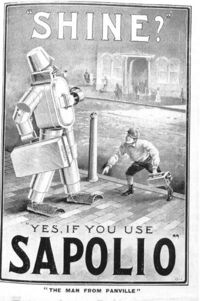
- The Tin Man was a common feature in political cartoons and in advertisements in the 1890s. Indeed, he had been part of European folk art for 300 years.[14]
- The oil needed by the Tin Woodman had a political dimension at the time because Rockefeller's Standard Oil Company stood accused of being a monopoly (which was later ruled correct in a lawsuit brought by the federal government, and ultimately affirmed by the US Supreme Court.) In the 1902 stage adaptation the Tin Woodman wonders what he would do if he ran out of oil. "You wouldn't be as badly off as John D. Rockefeller," the Scarecrow responds, "He'd lose six thousand dollars a minute if that happened."[15]
- The lion that Dorothy, Scarecrow and Tin-Man encounter in the enchanted forest may be a reference to William Jennings Bryan, the Democratic candidate for president in 1896. Cartoons often portrayed leading politicians as lions, and Bryan was described as having a great roar with no bite. People asked in early 1900, when the book was written, if he had the courage to oppose the McKinley Administration.
- In 1900 by far the most famous farmer in America was Henry Cantwell Wallace, editor of the leading farm magazine, Wallace's Farmer. Everyone called him "Uncle Henry."[16]
- "Aunt Em" is a puzzle. Baum's mother-in-law was named Matilda Joslyn Gage, and might be "Aunt M." Mary Lease the Populist spellbinder has been suggested. ("Raise less corn and more hell!" was her shocking message, but Aunt Em is not like her.) Gage was a leader of the woman suffrage movement, but nothing about the book's character suggests suffrage interests.
- The poppies which surround the Emerald City are likely a reference to the opium poppies and the Boxer Rebellion in China of 1899.[17]
- Politicians of the era often talked about wizards. For example, one senator debating the gold and silver issue in early 1900 said, “We all know of the performances of the world’s magicians, but it has remained for the Wizard of Missouri [Senator Cockrell] to wave his magic wand or his magic head and double the price of the silver of the world.”[18] Baum may have turned the Wizard of Missouri into the Wizard of Oz, who frightened people with his giant magic head.
- President McKinley was often called a "wizard" for his political skills. The Wizard of Oz seems to be the president of the Land of Oz. The "man behind the curtain" echoes the response to automated store window displays.
- Dogs were often used in political cartoons to represent politicians or parties. Perhaps "Toto" is a play on the word "teetotaler", and represents the Prohibitionists of the era, who were aligned with Bryan in the 1896 election.
- "Oz" is the abbreviation for "ounce," and it has been suggested that Baum was making a political allusion to bimetallism, a hot political topic of the day. The 1901 theatre version used many current political allusions, mentioning by name President Roosevelt and oilman John D. Rockefeller. In a press release for the 1903 reissue of Wizard, Baum wrote:[19]
I have a little cabinet letter file on my desk that is just in front of me. I was thinking and wondering about a title for the story, and had settled on the "Wizard" as part of it. My gaze was caught by the gilt letters on the three drawers of the cabinet. The first was A-G; the next drawer was labeled H-N and on the last were the letters O-Z. And "Oz" it at once became.[20]
Adaptations[edit]
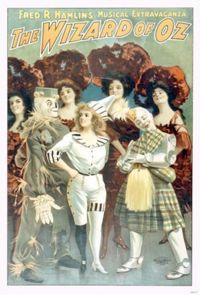
The Wizard inspired 40 official Oz books, 40 films, more than 100 unofficial novels, and innumerable websites, editorial cartoons, TV commercials, television shows, games, radio programs, video games, music videos, comic strips, musicals, toys, dolls, Japanese animes, ceramic firgurines, and even pornography, most of them based on the 1939 movie.[21] The copyright for the original books published before 1923 has expired, but the 1939 film will be under copyright for decades to come.
The earliest musical version of the book was produced in Chicago in 1902, and moved to Broadway in 1903, where it was a smash hit and set a record with 293 performances. It used the same characters, but was aimed at adult audiences. Baum inserted current political references to the script. For example, his actors specifically mention President Theodore Roosevelt, Senator Mark Hanna, and John D. Rockefeller by name.[22]
The musical comedy version of 1902-3 was a rewritten version for an adult audience, with many sexual innuendos and a very sexy Dorothy.
The Wizard of Oz (1939)[edit]

The book was loosely adapted into a 1939 motion picture, The Wizard of Oz, which has over the course of years become one of the most beloved movies of all time. It was released when Technicolor was still a relatively new process—the three-strip process having been introduced in 1932. It plays on the novelty of color by presenting the first reel, when Dorothy is awake and in the real world of Kansas, in sepia tone, then switching to color for the scenes set in Oz.
The film was successful and well reviewed and won two Academy Awards (for its score, and for the song "Over the Rainbow".) When it was released, the New York Times called it "a delightful piece of wonderworking," and said, "not since Disney's Snow White has anything quite so fantastic succeeded half so well," but complained about the special effects: "With the best of will and ingenuity [they cannot], without a few jolts and split-screen overlappings, bring down from the sky the great soap bubble in which the Good Witch rides and roll it smoothly into place."[23] During its production and following its release, it was thought to be a very good film, but nothing extraordinary: just part of the stream of fine, professional product that "the industry" in Hollywood knew how to manufacture. Not until it began to be shown on television did it rise to the status it now enjoys. It was first shown on CBS in 1956, then in 1959, then annually as a holiday event. (Viewers then had to be cautioned about the sepia tone opening reel lest they fear their color television sets were malfunctioning).
The plot of both the book and movie revolve around a little girl named Dorothy who, along with her dog Toto, finds herself transported into a world called Oz. Along the way, she befriends the Scarecrow, the Tinman, and the Cowardly Lion. Often considered a classic of children's literature, The Wizard of Oz deals with friendship, courage, and resourcefulness.
The Wiz (1978)[edit]
The Wiz was a Broadway hit musical with an all-black cast emphasizing the liberation from slavery. It was later made into a 1978 movie directed by Sidney Lumet, and starring Diana Ross as Dorothy and Michael Jackson as the Scarecrow. Gregory Maguire wrote Wicked: The Life and Times of the Wicked Witch of the West (1995). The 2003 Broadway musical "Wicked" (based on Maguire's novel) was a popular hit, with the Wizard's corruption emphasized.
See also[edit]
- Oz, for the other 40 Oz books
Bibliography[edit]
- Barrett, Laura. "From Wonderland to Wasteland: The Wonderful Wizard of Oz, The Great Gatsby, and the New American Fairy Tale," Papers on Language and Literature, (Spring 2006) online edition
- Baum, L. Frank. The Wonderful Wizard of Oz (1900), online edition with black and white illustrations; online version from Gutenberg, without illustrations
- Blythe, Martin. "Oz is China: A Political Fable of Chinese Dragons and White Tigers," in Sexual Fables (2006) online edition
- Clanton, Gene. Populism: The Humane Preference in America, 1890-1900 (1991)
- Culver, Stuart. "Growing Up in Oz." American Literary History 4 (1992) 607-28. 2.0.CO;2-H">in JSTOR
- Culver, Stuart. "What Manikins Want: The Wonderful Wizard of Oz and The Art of Decorating Dry Goods Windows and Interiors", Representations, 21 (1988) 97-116.
- Dighe, Ranjit S. ed. The Historian's Wizard of Oz: Reading L. Frank Baum's Classic as a Political and Monetary Allegory (2002) excerpt and text search
- Erisman, Fred. "L. Frank Baum and the Progressive Dilemma" in American Quarterly Vol. 20, No. 3 (Autumn, 1968), pp. 616–623. 2.0.CO;2-E">online at JSTOR
- Flynn, Richard. "Imitation Oz: The Sequel as Commodity." The Lion and the Unicorn 20.1 (1996): 121-131.
- Gardner, Todd. "Responses to Littlefield" (2004), online version
- Geer, John G. and Thomas R. Rochon, "William Jennings Bryan on the Yellow Brick Road," Journal of American Culture Vol. 16 No. 4, Winter, 1993, pp. 59–64.
- Gessel, Michael; Koupal, Nancy Tystad; and Erisman, Fred. "The Politics of Oz: a Symposium." South Dakota History 2001 31(2): 146-168. Issn: 0361-8676
- Gilead, Sarah. "Magic Abjured: Closure in Children's Fantasy Fiction" in PMLA Vol. 106, No. 2 (Mar., 1991), pp. 277–293. 2.0.CO;2-L">in JSTOR
- Griswold, Jerry. "There's No Place But Home: The Wizard of Oz. " The Antioch Review 45A (1987): 462-75.
- Hansen, Bradley A. "The Fable of the Allegory: The Wizard of Oz in Economics," Journal of Economic Education (2002) online edition
- Hearn, Michael Patrick. The Annotated Wizard of Oz. (2000, 1973), highly detailed guide to the 1900 book; ignores all political issues and metaphors, and ignores the source of the illustrations
- Hudlin, Edward R. "The Mythology of Oz: An Interpretation." Papers on Language and Literature 25.4 (1989): 443-462.
- Jensen, Richard. The Winning of the Midwest: Social and Political Conflict, 1888-1896 (1971), ch. 10, uses the Wizard to explain the politics of the 1890s
- Karp, Andrew. Utopian Tension in L. Frank Baum's Oz in Utopian Studies, 1998. online edition
- Kim, Helen M. "Strategic Credulity: Oz as Mass Cultural Parable" in Cultural Critique No. 33 (Spring, 1996), pp. 213–233. 2.0.CO;2-T">online at JSTOR
- Leach, William. Land of Desire: Merchants, Power, and the Rise of a New American Culture (1993), pp. 248–260. excerpt and text search
- Leach, William. "The Clown from Syracuse: The Life and Times of L. Frank Baum." introduction to Leach, ed. The Wonderful Wizard of Oz 1991. pp 1–34.
- Littlefield, Henry M. "The Wizard of Oz: Parable on Populism" American Quarterly Vol. 16, No. 1 (Spring, 1964), pp. 47–58; Littlefield was the first scholar to explore the allegories, though he mistakenly thought Baum supported Populism 2.0.CO;2-J">in JSTOR; another online version; another version
- Nesbet, Anne. "In Borrowed Balloons: The Wizard of Oz and the History of Soviet Aviation" in The Slavic and East European Journal Vol. 45, No. 1 (Spring, 2001), pp. 80–95. 2.0.CO;2-W">online at JSTOR
- Parker, David. "The Rise and Fall of The Wonderful Wizard of Oz as a 'Parable on Populism'" The Journal of the Georgia Association of Historians, vol. 15 (1994), pp. 49–63 online edition
- Riley, Michael O. Oz and Beyond: The Fantasy World of L. Frank Baum. (1997) University of Kansas Press ISBN 0-7006-0832-X excerpt and text search
- Ritter, Gretchen. Goldbugs and Greenbacks: The Anti-Monopoly Tradition and the Politics of Finance in America (1997) excerpt and text search
- Ritter, Gretchen. "Silver slippers and a golden cap: L. Frank Baum's The Wonderful Wizard of Oz and historical memory in American politics." Journal of American Studies (August 1997) vol. 31, no. 2, 171-203.
- Rockoff, Hugh. "The 'Wizard of Oz' as a Monetary Allegory," Journal of Political Economy 98 (1990): 739-60, the source most often used by economists 2.0.CO;2-5">online at JSTOR; another online edition
- Rogers, Katharine M. L. Frank Baum: Creator of Oz: A Biography (2002) excerpt and text search
- Sherman, Fraser A. The Wizard of Oz Catalog: L. Frank Baum's Novel, Its Sequels and Their Adaptations for Stage, Television, Movies, Radio, Music Videos, Comic Books, Commercials and More (2005)
- Swartz, Mark Evan. Oz Before the Rainbow: L. Frank Baum's "The Wonderful Wizard of Oz" on Stage and Screen to 1939 (2000).
- Quentin P. Taylor, "Money and Politics in the Land of Oz," (Dec 2004) Independent
- Velde, Francois R. "Following the Yellow Brick Road: How the United States Adopted the Gold Standard" Economic Perspectives. Volume: 26. Issue: 2. 2002. online edition also online here
- Von Hoffman, Nicholas. "Flimflam Land." Civilization, (Feb/Mar2000), Vol. 7, Issue 1, in EBSCO
- Ziaukas, Tim. "100 Years of Oz: Baum's 'Wizard of Oz' as Gilded Age Public Relations" in Public Relations Quarterly, (Fall 1998) online version
External links[edit]
- full text of 6 Oz books by Baum
- A history of the debate
- Collection of material relating to Oz as a political allegory
- Humbug: The Most Destructive Film in History by Paul Niquette
- Oz as a spiritual allegory
- Pros and cons of Oz as an allegory
Trivia[edit]
- In 2009, the movie will celebrate its 70th anniversary.
- The movie can supposedly be synched with Pink Floyd's classic album The Dark Side of the Moon.[24]
- A "yellow brick road" can be found in Liberal, Kansas.
- Many parodies of it have been made. Recently, one such was The Wizard of Ha's on Veggie Tales, with changes to match the Story of the Prodigal Son.
Notes and references[edit]
- ↑ There have been many later film and dramatic spinoffs, as well as books, trinkets, and toys based on the Wizard and the other memorable characters. It was originally a very popular children's book written by L. Frank Baum in 1900, which started a series.
- ↑ http://birthmoviesdeath.com/2013/02/25/the-time-the-wicked-witch-of-the-west-was-too-scary-for-sesame-street
- ↑ https://parade.com/914161/samuelmurrian/wizard-of-oz-facts/
- ↑ https://news.yahoo.com/wizard-oz-cursed-truth-behind-200016520.html
- ↑ see Michael Patrick Hearn, "The Man Behind the Man Behind Oz: W. W. Denslow at 150," AIGA (July 05, 2006) at [1]
- ↑ https://www.quora.com/What-was-the-first-movie-made-in-color
- ↑ http://www.amerisearch.net/index.php?date=2004-08-31&view=View
- ↑ Culver (1988)
- ↑ Baum's son said he thought his father got the name from a file cabinet labeled A-N and O-Z.
- ↑ Quoted in , Nicholas Von Hoffman, "Flimflam Land. Civilization, Feb/Mar2000, Vol. 7, Issue 1
- ↑ The party is now part of Minnesota's Democratic-Farmer-Labor Party
- ↑ Littlefield (1964), followed by others. saw her as the western drought which thus could be ended by water; Clanton (1991) suggests she represents the evils of left-wing Populism, or perhaps South Carolina' Pitchfork Ben Tillman,
- ↑ L. Frank Baum, introduction to The Wonderful Wizard of Oz
- ↑ Archie Green, Tin Men (2002) excerpt and text search covers the history of images of tin men in European and American illustrations for 300 years.
- ↑ Swartz, Oz p 34
- ↑ Henry Wallace and Richard S. Kirkendall. Uncle Henry: A Documentary Profile of the First Henry Wallace (1993) excerpt and text search
- ↑ See the fascinating analysis by Martin Blythe, "Oz is China" (2006) online edition
- ↑ New York Times February 16, 1900 p 1
- ↑ http://home.earthlink.net/~jcorbally/eng218/rcross.html
- ↑ http://www.snopes.com/language/literary/oz.asp
- ↑ Sherman, (2005)
- ↑ Swartz, Before the Rainbow, pp 34, 47, 56
- ↑ Nugent, Frank S. (1939), "The Screen in Review: 'The Wizard of Oz, Produced by the Wizards of Hollywood, Works Its Magic on the Capitol's Screen—March of Time Features New York," The New York Times, August 18, 1939, p. 16
- ↑ http://www.ingsoc.com/waters/info/oz.html
External links[edit]
- The Wonderful Wizard of Oz, by L. Frank Baum - Audiobook at LibriVox
Categories: [Literature] [Movies] [Fantasy] [Progressive Era] [New Deal] [Witchcraft]
↧ Download as ZWI file | Last modified: 03/12/2023 21:08:44 | 16 views
☰ Source: https://www.conservapedia.com/The_Wizard_of_Oz | License: CC BY-SA 3.0
 ZWI signed:
ZWI signed:

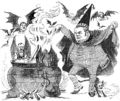







 KSF
KSF